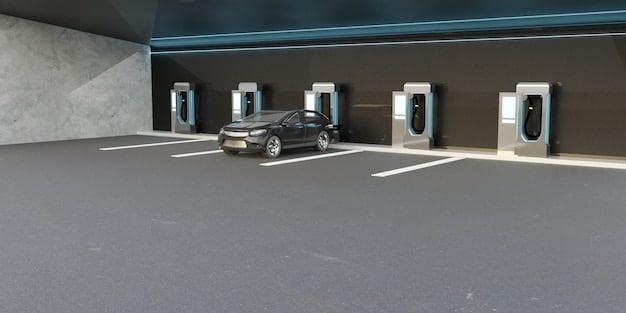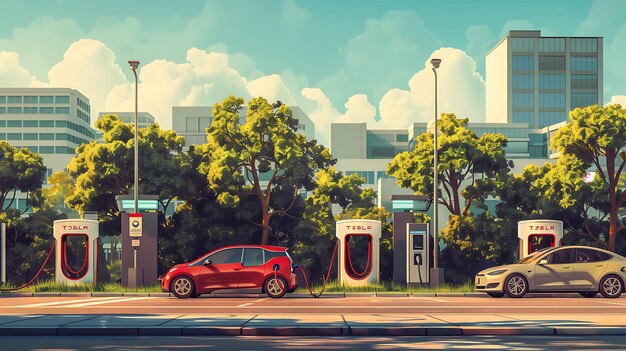Electric Vehicle Charging Infrastructure Growth: US Predictions

The latest predictions for the growth of the electric vehicle charging infrastructure market in the US indicate a significant expansion driven by increasing EV adoption, government incentives, and technological advancements, leading to a more robust and accessible charging network across the country.
The electric vehicle charging infrastructure market in the US is experiencing unprecedented growth. As more drivers switch to electric vehicles, the demand for accessible and reliable charging solutions is surging. But what are the forecasts for this rapidly evolving landscape?
Forecasting the Expansion of US EV Charging Infrastructure
The electric vehicle market is gaining momentum, and the growth of the electric vehicle charging infrastructure market in the US is crucial to support this transition. Understanding the latest predictions helps stakeholders make informed decisions and prepare for the future of transportation.
Let’s delve into the key factors driving this growth and explore the most recent forecasts.
Key Drivers Fueling Market Growth
Several factors are propelling the expansion of the US EV charging infrastructure market. Government policies, technological advancements, and increasing consumer demand are at the forefront.
- Government Incentives: Federal and state-level incentives, such as tax credits and grants, are encouraging the installation of charging stations.
- Technological Advancements: Innovations in charging technology, including faster charging speeds and improved battery technology, are making EVs more appealing.
- Consumer Demand: As EV adoption rates rise, the demand for convenient and reliable charging infrastructure is also increasing.
These drivers are creating a positive feedback loop, where increased charging infrastructure supports greater EV adoption, further fueling demand for more charging stations.
Current Market Size and Growth Rate
To understand future predictions, it’s essential to grasp the current market size and growth rate of the US EV charging infrastructure market. This provides a baseline for assessing potential future expansion.
The market has seen remarkable growth in recent years, and experts anticipate this trend to continue.

Market Size
The US EV charging infrastructure market is currently valued at billions of dollars, with projections indicating substantial growth over the next decade. The exact figures vary depending on the source, but the overall trend is clear: significant expansion is on the horizon.
Growth Rate
The annual growth rate of the EV charging infrastructure market in the US is estimated to be in the double digits. This rapid growth is driven by the factors mentioned earlier, including government incentives and increasing EV adoption.
The combination of a large market size and a high growth rate makes the US EV charging infrastructure market an attractive investment opportunity.
Near-Term Predictions (Next 1-3 Years)
Looking at the near-term predictions for the electric vehicle charging infrastructure market in the US offers insights into the immediate future of this sector. These forecasts often focus on specific milestones and policy impacts.
The next few years are expected to be critical for establishing a robust and reliable charging network.
Infrastructure Build-Out
Near-term predictions suggest a significant increase in the number of charging stations across the US. This includes both public and private charging infrastructure, with a focus on expanding coverage in underserved areas.
Experts forecast a surge in the installation of fast-charging stations to reduce charging times and enhance the convenience of EV ownership.
Policy Impact
Government policies, such as the Bipartisan Infrastructure Law, are expected to play a crucial role in shaping the near-term growth of the EV charging infrastructure market. These policies provide funding for charging station deployment and support the development of industry standards.
The successful implementation of these policies will be vital in accelerating the transition to electric vehicles.
Long-Term Projections (5-10 Years)
Long-term projections for the electric vehicle charging infrastructure market in the US provide a broader perspective on the potential future of this industry. These forecasts consider factors such as technological advancements, market trends, and policy changes.
The next decade is expected to bring transformative changes to the EV charging landscape.

Technological Innovations
Long-term projections anticipate significant advancements in charging technology. This includes the development of ultra-fast charging systems, wireless charging technology, and bidirectional charging capabilities.
Innovations in battery technology are also expected to impact the charging infrastructure market, with longer-range batteries reducing the frequency of charging and potentially altering charging patterns.
Market Dominance
Experts predict that a few dominant players will emerge in the EV charging infrastructure market over the next decade. These companies will likely control a significant share of the charging station network and play a key role in shaping industry standards.
- Establishing brand recognition and customer loyalty
- Forging strategic partnerships with automakers and energy providers
- Investing in research and development to stay ahead of the curve
These factors will determine which companies ultimately succeed in dominating the EV charging infrastructure market.
Regional Variations in Market Growth
The growth of the electric vehicle charging infrastructure market in the US is not uniform across all regions. Different states and cities have varying adoption rates, policy environments, and infrastructure development plans. Understanding these regional variations is crucial for stakeholders.
Some regions are leading the way in EV adoption and charging infrastructure deployment, while others are lagging behind.
Leading States
States like California, New York, and Massachusetts are at the forefront of EV adoption and charging infrastructure development. These states have implemented aggressive policies to promote electric vehicles and have invested heavily in charging infrastructure.
These states serve as models for other regions looking to accelerate the transition to electric vehicles.
Emerging Markets
Other states, such as Texas, Florida, and North Carolina, are emerging as key markets for EV adoption and charging infrastructure development. These states have a growing population and a increasing interest in electric vehicles.
The growth of the EV charging infrastructure market in these emerging markets will be critical to achieving national electrification goals.
Challenges and Opportunities
While the electric vehicle charging infrastructure market in the US offers significant opportunities, it also faces several challenges. Addressing these challenges will be essential to realizing the full potential of this market.
Overcoming obstacles and capitalizing on opportunities will drive sustainable growth.
Challenges
One of the key challenges facing the EV charging infrastructure market is the high cost of installation and maintenance. Charging stations can be expensive to install, and ongoing maintenance costs can add up over time.
Other challenges include grid capacity constraints, standardization issues, and concerns about cybersecurity.
Opportunities
Despite these challenges, the EV charging infrastructure market offers numerous opportunities. The increasing demand for electric vehicles, coupled with government incentives and technological advancements, creates a favorable environment for growth.
Opportunities also exist in areas such as smart charging, energy storage, and renewable energy integration.
| Key Point | Brief Description |
|---|---|
| ⚡️ Market Expansion | Significant growth driven by EV adoption and incentives. |
| 📈 Government Role | Policies and funding accelerate charging infrastructure. |
| 💡 Tech Advancements | Faster charging & battery tech enhance EV appeal. |
| 🌎 Regional Disparity | Growth varies; some states lead while others emerge. |
Is EV charging infrastructure growth sustainable?
▼
Government incentives, technological advancements in charging speeds and battery tech, and rising consumer demand for EVs drive the market’s expansion.
▼
Expect a significant increase in charging stations, with a surge in fast-charging installations fueled by government policies and infrastructure investments.
▼
Long-term projections consider technological advancements such as wireless and bi-directional charging, along with market consolidation and the emergence of dominant players.
▼
California, New York, and Massachusetts are leading due to proactive policies and investments, while states like Texas and Florida are emerging markets.
▼
High installation and maintenance costs, grid capacity limitations, standardization issues, and cybersecurity concerns are key obstacles to overcome.
Conclusion
The electric vehicle charging infrastructure market in the US is poised for significant growth, driven by increasing EV adoption, government support, and technological innovation. While challenges remain, the opportunities are substantial, offering potential for both economic and environmental benefits. Monitoring regional variations and addressing key obstacles will be crucial to realizing the full potential of this dynamic market.





